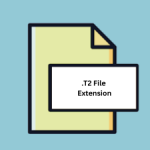.OVF File Extension

Open Virtualization File
| Developer | VMware |
| Popularity | |
| Category | Data Files |
| Format | .OVF |
| Cross Platform | Update Soon |
What is an OVF file?
Open Virtualization Format (.OVF) files are a crucial component in the realm of virtualization. These files encapsulate an entire virtual machine (VM) setup, including its configuration, disk images, and other necessary information. Essentially, OVF is a standardized packaging format that simplifies the distribution and deployment of virtual appliances.
More Information.
OVF was born out of the need for a universal format that could encapsulate all aspects of a virtual machine, allowing for seamless deployment and interoperability across diverse virtualization environments. The primary goal was to provide a vendor-neutral, open standard that fosters compatibility among various virtualization solutions.
Origin Of This File.
The Open Virtualization Format emerged as an industry standard developed by the Distributed Management Task Force (DMTF). Initially introduced in 2007, OVF was designed to address the challenges associated with portability and distribution of virtual machines across different virtualization platforms.
File Structure Technical Specification.
OVF files consist of XML descriptors that define the virtual machine configuration, including details about the virtual hardware, disk images, networking settings, and more. The technical specifications are meticulously outlined by the DMTF, ensuring a consistent structure that facilitates easy interpretation and implementation across different virtualization platforms.
How to Convert the File?
Windows:
Converting .OVF files on Windows is a straightforward process, primarily facilitated by popular virtualization software like VMware Workstation. Here’s a step-by-step guide:
- Install VMware Workstation: Ensure VMware Workstation is installed on your Windows system. You can download and install it from the official VMware website.
- Open VMware Workstation: Launch the VMware Workstation application on your Windows machine.
- Import the OVF File:
- Click on “File” in the menu.
- Select “Open” and choose “Import OVF.”
- Browse to the location of your .OVF file and select it.
- Follow the on-screen prompts to complete the import process.
- Configure Virtual Machine Settings: Adjust any necessary settings, such as virtual hardware specifications and network configurations, according to your requirements.
- Finish the Process: Click “Finish” to complete the conversion. VMware Workstation will create a new virtual machine based on the information from the OVF file.
- Power On the Virtual Machine: Start the virtual machine to initiate the operating system within the virtualized environment.
Linux:
Linux users can convert .OVF files using virtualization solutions like Virtual Machine Manager (Virt-Manager) or QEMU. Here’s a step-by-step guide using Virt-Manager:
- Install Virt-Manager: Ensure Virt-Manager is installed on your Linux system. You can typically install it using your distribution’s package manager.
- Open Virt-Manager: Launch Virt-Manager either from the application menu or by running it from the terminal.
- Import the OVF File:
- Click on “File” and select “Import Existing Disk Image.”
- Choose the .OVF file and follow the on-screen instructions to import it.
- Configure Virtual Machine Settings: Adjust settings such as memory, CPU, and storage as needed.
- Complete the Import: Proceed to complete the import process, and Virt-Manager will create a new virtual machine based on the OVF file.
- Start the Virtual Machine: Power on the virtual machine to initiate the operating system within the virtualized environment.
Mac:
On Mac systems, you can use virtualization software like VMware Fusion to convert .OVF files:
- Install VMware Fusion: Ensure VMware Fusion is installed on your Mac. Download and install it from the official VMware website.
- Open VMware Fusion: Launch VMware Fusion on your Mac.
- Import the OVF File:
- Click on “File” in the menu.
- Choose “Import” and select “Import an existing virtual machine.”
- Browse to the location of your .OVF file and select it.
- Follow the on-screen prompts to complete the import process.
- Adjust Settings (if necessary): Modify any virtual machine settings, such as hardware specifications and networking configurations.
- Complete the Import: Click “Finish” to complete the import process, and VMware Fusion will create a new virtual machine based on the OVF file.
- Start the Virtual Machine: Power on the virtual machine to initiate the operating system within the virtualized environment.
Android:
Converting .OVF files on Android involves accessing virtual machines through remote desktop applications rather than direct conversion. Here’s a general guide:
- Install a Remote Desktop App: Download and install a remote desktop application on your Android device. Apps like Microsoft Remote Desktop or AnyDesk are popular choices.
- Set Up Remote Connection:
- Open the remote desktop app.
- Set up a new connection and provide the necessary details, including the IP address or hostname of the machine running the virtual machine.
- Connect to Virtual Machine: Once configured, connect to the remote machine. This allows you to access and control the virtual machine running on another system.
iOS:
Similarly, converting .OVF files on iOS involves using remote desktop applications for accessing virtual machines. Here’s a general guide:
- Install a Remote Desktop App: Download and install a remote desktop application on your iOS device. Microsoft Remote Desktop or AnyDesk are commonly used options.
- Configure Remote Connection:
- Open the remote desktop app.
- Create a new connection and input the necessary details, including the IP address or hostname of the machine where the virtual machine is running.
- Connect to Virtual Machine: Once configured, establish a connection to the remote machine. This enables you to interact with and control the virtual machine located on another system.
Advantages And Disadvantages.
Advantages:
- Portability: OVF enhances the portability of virtual machines, allowing seamless movement between different virtualization platforms.
- Interoperability: Being an open standard, OVF promotes interoperability among various virtualization solutions, fostering a more flexible and diverse virtualization ecosystem.
- Ease of Deployment: OVF simplifies the deployment process by encapsulating the entire virtual machine configuration in a single, standardized file.
Disadvantages:
- Complexity: Creating and managing OVF files can be complex, especially for users with limited experience in virtualization technologies.
- Limited Feature Set: OVF may not support all advanced features of specific virtualization platforms, potentially limiting the functionality in some cases.
How to Open OVF?
Open In Windows
To open OVF files in Windows, users can leverage virtualization software such as VMware Workstation, Oracle VirtualBox, or Microsoft Hyper-V. These applications provide options to import and deploy virtual machines from OVF files seamlessly.
Open In Linux
Linux users can utilize virtualization solutions like KVM (Kernel-based Virtual Machine) or Virtual Machine Manager to open OVF files. The process typically involves importing the virtual machine configuration and associated disk images into the chosen virtualization platform.
Open In MAC
On Mac systems, virtualization software like VMware Fusion or VirtualBox can be employed to open OVF files. Users can import the OVF file through the software’s interface, initiating the creation of the virtual machine.
Open In Android
While direct OVF file support on Android may be limited, users can explore apps or solutions that facilitate remote access to virtual machines hosted on other platforms. Utilizing remote desktop applications may be a viable option for accessing OVF-based virtual machines.
Open In IOS
Similar to Android, iOS devices may not have native support for OVF files. Users can explore remote desktop solutions or apps that enable connectivity to virtual machines running on other platforms.
Open in Others
For other platforms, the process largely involves using virtualization software compatible with the respective operating systems. Applications like QEMU, Xen, and others may support OVF files, providing options for importing and deploying virtual machines.













